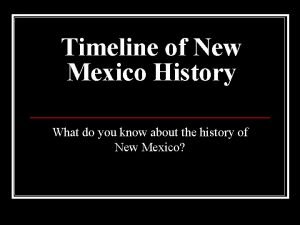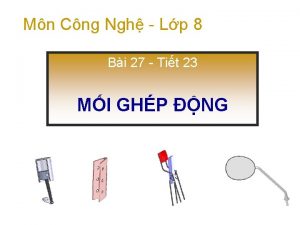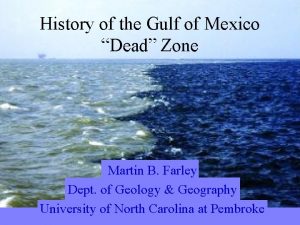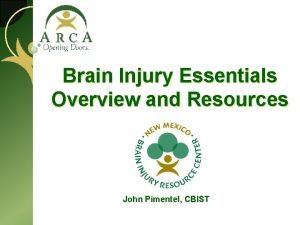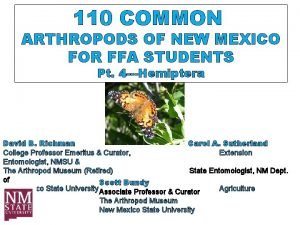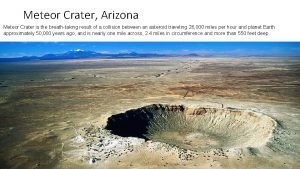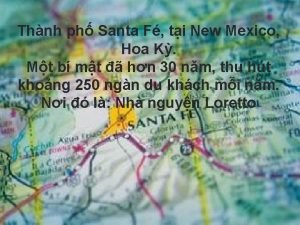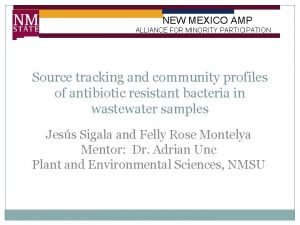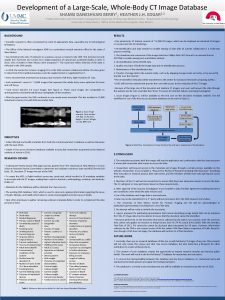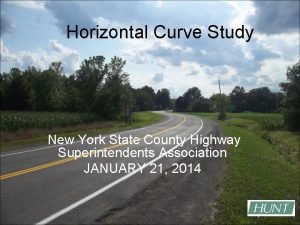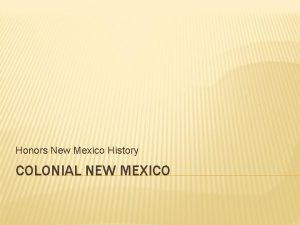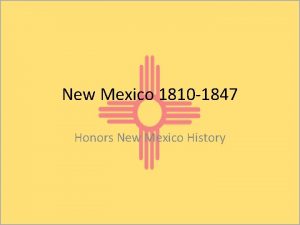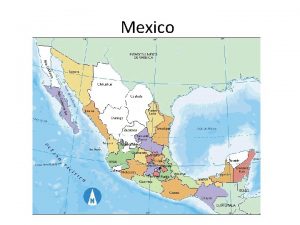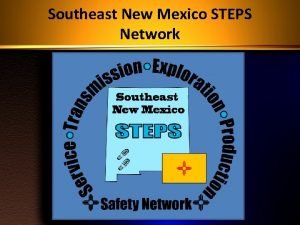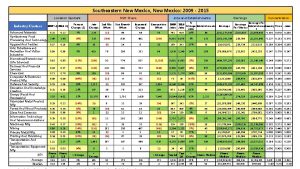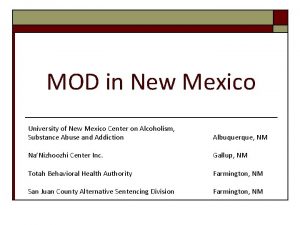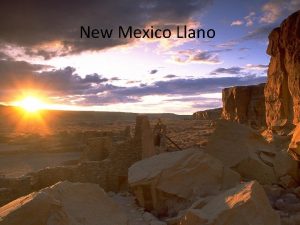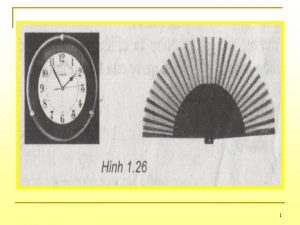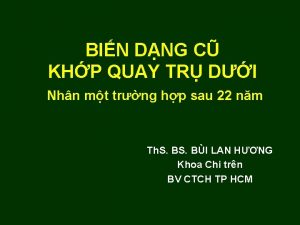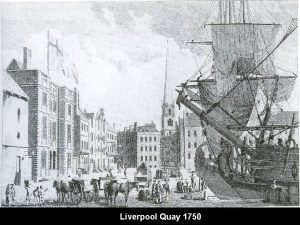A Pictorial History of Quay County New Mexico























































- Slides: 55

A Pictorial History of Quay County, New Mexico Agriculture in the 20 th Century By Jeff Bader Quay County Agricultural Extension Agent Special thanks to Tucumcari Historical Museum, Tucumcari/Quay County Chamber of Commerce, Tucumcari Agricultural Science Center, Quay County Extension Office and Private Collections for the photographs presented here.

Free Land Bureau in Logan N. M. around the turn of the Century.

Tucumcari Field Station, 1903. Became the New Mexico State University Agricultural Science Center.

Quay County Fair Exhibit, 1908.

By some accounts, Montoya N. M. in the early 1900’s had upto 1000 people living there, now only a handful remain.

Farm products raised by R. B. Waltrip - 1916.

Bell Street, Nara Visa, NM about the turn of the century.

Dryland peach orchard, 1916.

Rabbit drives were common in Eastern NM in the early 1900’s. Drivers walked side by side and killed every rabbit that crossed their path. This one took place at Mc. Alister, N. M. in 1917. 600 Rabbits were taken that day.

Homesteading in Quay County about 1900. Mary Lou Hornsby’s homestead. Dugout in Montoya, N. M. .

San Jon, N. M. Broom Corn processing Scenes, 1920’s.

“Bugger Red” bull- dogging from a car at the Cowboy Roundup in Tucumcari around 1920.

Branding at the Kohn Ranch (T 4 Cattle Company) in the early 1920’s.

Mules for sale in Downtown Tucumcari at the site that later became the Elk Drug Store.

Roundup on the T 4 Ranch, early 1920’s.

First modern cotton gin in Quay County, 1922, San Jon, N. M.

Cultivating Cowpeas at what is now the New Mexico State University Agricultural Science Center at Tucumcari.

T 4 Cowboys in the early 1920’s.

Processing silage at the Tucumcari Field Station. Parts of these buildings remain today.

400 cattle killed by the US Government on the T 4 Ranch due to drought. The Ranch Received $9 per head compensation.

Hereford cattle were dominant in Quay County for the first 80 years of the 20 th Century.

Duke Hornsby building fence, 1940’s.

Branding with a wood fire.

Harvesting Potatoes

The Arch Hurley Conservancy District was completed in the late 1940’s and brought irrigated agriculture to Quay County.

Boys in the cantaloupe patch, 1940’s.

Broom Corn (1949 ) was a major crop in Quay County until the 1960’s.

Castor Beans are one of the many crops that have been grown in Quay County. The slides that follow show others.

Sugar Beets

Melons

Sweet Potatoes

Onions

Cutting Alfalfa, 1949. Alfalfa has become the #1 forage crop today.

Man and wife working the new irrigation project, late 1940’s.

Picking cotton, 1940’s.

Early weed and insect control in cotton.

Wheat Harvest, late 1940’s.

Wheat on the ground, in Tucumcari, before the grain elevator was finished (in the background) 1946.

The “Packin House”, 1950’s.

Roger Harrell’s Champion Market Calf, New Mexico State Fair, sold for $1500 in 1949.

Mesa Country in the 1950’s.

4 H Livestock demonstration by H. W. Koonsman and Tommy Smith, 1950.

Picking horses out of the remuda, early 1950’s.

Horses have always been an important part of Quay County Agriculture.

The Quay County Cooperative Extension Service was lucky to have Travis Nelson and Ted Peabody working for a better future for all residents.

Tucumcari Farmers Market, 1999

Modern irrigation techniques are becoming more popular every year.

The old and the new come together.

Jose Tall Wheatgrass and Alfalfa mixes are the improved pastures of choice today.

Modern farming techniques in the Arch Hurley Conservancy District.

Bringing the herd off of Mesa Rica.

Triticale and Tucumcari Mountain.

The preferred way to package hay today.

Another way to package alfalfa.

Nuff Said
 Oblique pictorial
Oblique pictorial New mexico time line
New mexico time line Leak homophone
Leak homophone Yjb quay
Yjb quay Khớp tịnh tiến là gì
Khớp tịnh tiến là gì Mối ghép pittông xilanh có mặt tiếp xúc là
Mối ghép pittông xilanh có mặt tiếp xúc là Lò quay
Lò quay Trái đất quay quanh mặt trời
Trái đất quay quanh mặt trời Aviation medicine advisory service
Aviation medicine advisory service Xương cẳng tay
Xương cẳng tay Tứ giác velpeau
Tứ giác velpeau Maaike bomers advocaat
Maaike bomers advocaat Gulf of mexico history
Gulf of mexico history New mexico insurance pool
New mexico insurance pool Interlock license new mexico
Interlock license new mexico New mexico brain injury resource center
New mexico brain injury resource center Form acd31075
Form acd31075 Nm pmp aware
Nm pmp aware New mexico ffa
New mexico ffa Cte school new mexico
Cte school new mexico Beaverhead crater
Beaverhead crater New mexico tech
New mexico tech F ti
F ti Sunset baseball field
Sunset baseball field Special olympics new mexico
Special olympics new mexico New mexico amp
New mexico amp Independent petroleum association of new mexico
Independent petroleum association of new mexico Cascrote
Cascrote New mexico privacy
New mexico privacy New mexico interstate stream commission
New mexico interstate stream commission New mexico food safety
New mexico food safety Unm im residency
Unm im residency New mexico decedent image database
New mexico decedent image database New mexico public school insurance authority
New mexico public school insurance authority Escambia county us history eoc
Escambia county us history eoc Pg county zoning ordinance
Pg county zoning ordinance New york state county highway superintendents association
New york state county highway superintendents association History also history physical
History also history physical History is bunk brave new world
History is bunk brave new world World history
World history New imperialism definition ap world history
New imperialism definition ap world history Us history eoc review the great depression and the new deal
Us history eoc review the great depression and the new deal Split speech punctuation
Split speech punctuation New york pennsylvania new jersey delaware
New york pennsylvania new jersey delaware New oil and new wineskin
New oil and new wineskin Orchard 14 marquee cinema
Orchard 14 marquee cinema Characteristics of the articles of confederation
Characteristics of the articles of confederation New-old approach to creating new ventures
New-old approach to creating new ventures The actual and potential rival offerings and substitutes
The actual and potential rival offerings and substitutes New years old is new again
New years old is new again New classical and new keynesian macroeconomics
New classical and new keynesian macroeconomics Chapter 16 toward a new heaven and a new earth
Chapter 16 toward a new heaven and a new earth Leanne keene french ambassador arrives from paris
Leanne keene french ambassador arrives from paris New classical and new keynesian macroeconomics
New classical and new keynesian macroeconomics Roosevelt vs taft progressivism venn diagram
Roosevelt vs taft progressivism venn diagram Cavalier vs cabinet oblique
Cavalier vs cabinet oblique

